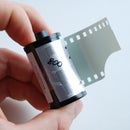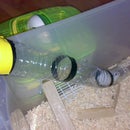Introduction: RGBike POV - Open Project
This i'ble is in constant update. If you're planning on doing something don't be afraid to drop a question.
I've always wanted a POV for my bicycle, specially a full colour POV capable of displaying text, images and small animations!
There are some cool POVs commercially available.
- SpokePOV from adafruit industries (and its i'ble)
- Monkeylectric's m132s
- Monkeylectric's recentely announced m464q
Unfortunately, the SpokePOV is only one colour, and the m132s, as I understand, doesn't have the ability to display images. Besides, I think these are a little too expensive for something that I will not use often.
So I though I would try to make my own with components I already had around. This way I don't have to spend any more money to try and play with a bicycle POV.
This project features:
- 16 RGB (Red+Green+Blue) Light Emitting Diodes;
- Arduino compatibility (Suposedely, I'll have to check that later);
- Single layer printed circuit board, suitable for home fab;
- All through hole componentes, suitable for beginners;
- Hall effect sensor, for image synchronization;
- Least number of componentes possible;
- Unfortunately, only one side of the wheel is illuminated (check update).
- Fits 26" wheels, I haven't had opportunity to try it in 20" and 24" wheels.
Update: I updated the board, so you can use only one board for lighting both sides of the wheel! But it won't work correctly in both sides for text...
Step 1: Before Starting
- Solder electronics
- Make printed circuits boards
- Understand basic principles of electronics
- Know a little about microcontrollers
Tools
You'll need the basic tools to:
- Make PCB
- Work with and solder electronics
- Hardware and software to program the microcontroller
- 1x ATMega328p / ATMega168 microcontroller - ~4.3$
- 1x TLC5940 / TLC5941, 16 PWM Ouput LED driver - ~4.29$
- 16x Superflux common cathode RGB LEDs - ~13$
- 1x A3213 - 1.5$
- 3x PN2222, NPN transistors - cents
- Assorted resistors, capacitors, tact switches and connectors (check schematic and board layout) - another few cents
Download all the resources
Don't forget to download the schematic and board layout for Eagle CAD, and the source code for the firmware.
attention: TobyTetzi noticed that he download '.tmp' files instead of the .brd and .sch files. It also happened to me. I don't understand why.
I changed back to the original name and it seems to solve it.
Step 2: Working Principle
So... You may ask. How do I plan to control the 48 LEDs? The 16 red, 16 green and 16 blue, with only a LED driver IC with 16 outputs?
Well... I'm going to light one colour at a time.
Imagine one line of the image in the wheel. This line is composed by red, green and blue points. These points will light up, in the same instant, one colour at a time. This alternation between the three colours is so fast, that you seem to see only one line.
If you alternate between all these colours, you won't see three lines of different colours, you'll see white.
To control the width of this line in the wheel, we only need to control how many times this line is repeated.
Since the driver IC sinks the LEDs, this method requires common cathod RGB LEDs.
I used cheap 'Piranha'/'Superflux' RGB LEDs from China.
Step 3: Make the Printed Circuit Board
If you don't know how to make a PCB, you can follow the ton of i'bles that are available.
There are a few methods of making PCBs, and many make it a little different within the same method.
I know at least:
- Photoresist - The method that I use. I can achieve great level of detail;
- Tonner transfer - You'll have to use a laser printer;
- Blue thingy transfer (don't remember the name) - I really don't like the process and the detail I achieve.
Resuming all the steps I took:
1 - Print the board layout in a transparency. In eagle go to: ULP -> CAMtoPrint;
2 - Prepare the copper and apply photoresist, like Positiv 20;
3 - Expose the copper with photoresist through the transparency;
4 - Develop the photoresist;
5 - Check for errors;
6 - Etch the board;
7 - Cut the board;
8 - Drill.
Step 4: Solder the Components
After making the PCB, you'll solder the components.
Follow the schematic and board layout to populate the board.
I suggest you to start with the microcontroller related stuff, and test it first.
Don't forget to solder the jumper wires!
Then solder all the LEDs and TLC5940 and all the remaining components.
Properly secure the batteries, otherwise it'll fly away! (check the video)
Since I didn't have the battery holders that I placed in the board layout, I had to use another kind of holder.
Step 5: The TLC5940 Driver
Cool projects that use this integrated circuit:
I will explain how this IC works and how to interface with it. Later... someday I hope.
Maximum LED current
You can limit the current that flows through the LEDs by specifying the value of a single resistor.to c
To calculate the resistor value, you need to decide the maximum value for the current on the LEDs (I_max).
R_iref = 39 / I_max
I used a 2.2k Ohm resistor, which limits the current to 17,7mA.
Step 6: Program the Microcontroller With the Firmware
You can now program the firmware into the microcontroller.
I use the USBtinyISP by ladyada.
I also designed this POV to be compatible with the Arduino. You just have to use the FTDI USB-TTL232 cable. But don't take my word for it, test it! (because I didn't).
There is also a TLC5940 library for the arduino by Alex Leone
Currently in this version of firmware you can only display one image, but you can easily tweak it. Also, the image data is read from program memory.
In the future I plan to try a SPI EEPROM connected to the serial port. This way I am able to store tons of images and animations!
In this version there is also a small section of feedback control loop, to synchronize the image to the velocity of the wheel.
How much space do I need for my image?
Depends on the level of detail you desire. With level of detail, I mean the number of divisions of your wheel.
If want to use 100 divisions, you'll divide the circle in lines with 3.6 deg. The greater the number of divisions, the narrower the lines.
For one image of 100 lines:
192 bits for each colour * 3 colours for line = 576 bits / 72 bytes for each line
72 bytes/line * 100 lines = 7200 bytes/image, ~7kBytes/image
Step 7: Install It on the Wheel
Now we will install the POV in the wheel.
I wish this POV could be installed in any kind of wheel. Specialy in 20", 24" and 26" wheels. Unfortunately, while I designing the board I didn't have access to any other wheel other than 26".
If you happen to try this POV in any other size, please tell me.
To install the POV you'll need:
- Pieces of foam or rubber;
- Zip-ties or any kind of string
- Magnets;
- Any other stuff you may find useful.
Secure it to the spokes, making sure the LEDs are perpendicular in the wheel.
Hall effect sensor
If you use a cable extension for the sensor as I did, you can place the sensor and the magnet in any place you seem fit.
Make sure that the magnet is in range of the sensor. It is important if you want to display an image.
Step 8: A Colourful Wheel!
Yay!
I can now draw images in my wheels, small animations and cool effects.
In the future I hope to make some piece of software that transforms an image into the data matrix that I use in the firmware. Also further develop some kind of interface to the computer and add some kind of memory to store the images and animations.
Update: I now duplicated the LEDs, thus making it visible in both sides of the wheel! This only works when you can mirror the image, i.e. not suitable for text.
Remember, if you feel like to tweak, contribute or develop for this project, you can do it! As long as you distribute it in the same conditions.
Soon... Some videos and some more photos.
Step 9: Space Invaders!
My latest animation! Some aliens walking in my wheel!
Runner Up in the
Get the LED Out! Contest
Participated in the
Get the LED Out! Contest














